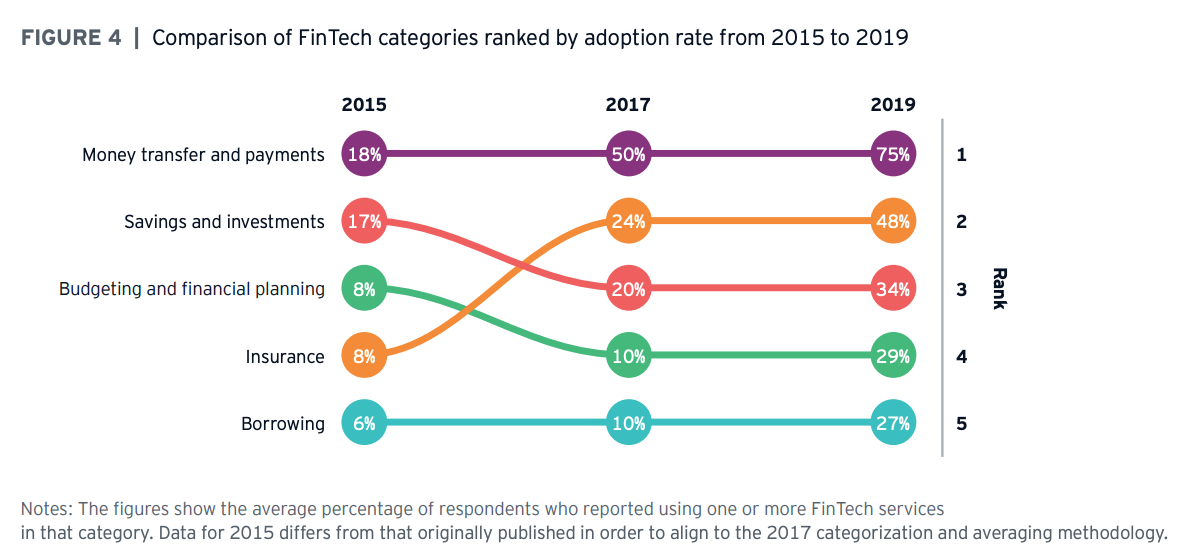
Global Fintech Adoption Is at an All Time High, EY Study Shows
by Fintech News Singapore June 18, 2019Consumer adoption of fintech services has surged globally in the past years, rising from 16% in 2015 and 33% in 2017, to now 64%, an increase of almost 100% every two years.
China and India are leading the trend with both markets recording a staggering consumer adoption rate of 87% respectively, according to EY’s Global Fintech Adoption Index 2019.
EY, which surveyed more than 27,000 consumers across 27 global markets to gauge the state of fintech adoption around the world, found that the rise of online banking and mobile-first platforms has fueled usage of fintech products and services, which have become mainstream.
Consumer awareness is at an all-time high with 96% of respondents stating they were aware of fintech transfer or payments services. 89% are aware of in-store mobile phone payment platforms and 82% are aware of peer-to-peer payment systems and non-bank money transfers, the survey found.
Money transfer and payments services are the most commonly used fintech categories (75%), followed by financial insurance (48%), savings and investments (34%) and budgeting and financial planning (29%).

Compared to previous years, fintech adopters are more willing to share data with 48% stating that were willing to do so if it meant accessing better deals from their service provider.
Fintech industry matures
According to EY, fintech has evolved beyond its early stages and challengers are now looking less like startups and more like professionally managed companies with broad operational capabilities, a full suite of products and a global reach.
Fintech services that are at once personalized, accessible, transparent, frictionless and cost-effective were considered new and disruptive in 2015, but today, these characteristics are a prerequisite for all players. With so many providers offering similar services, each company now must differentiate itself to attract and retain customers, whether by brand, price or execution, EY says.
One telling sign of the fintech industry’s maturation is the evolution of consumer priorities when looking for a fintech provider, the report notes. Two years ago 30% cited the ease of opening an account as their top priority and only 13% said attractive fees and prices were most important, the 2019 survey shows that consumers are now prioritizing price (27%), followed by ease of opening an account (20%).
“Fintech organizations are no longer fringe disruptors and have grown into sophisticated competitors,” said Matt Hatch, partner at Ernst & Young LLP and fintech leader at EY Americas fintech leader.
“Now, financial incumbents are taking note and offering fintech solutions, forming ecosystems that are replacing traditional partnerships. We fully expect this trend to accelerate as non-financial companies enter the space and leverage technology and innovation to provide frictionless, transparent and highly-personalized services.”
China and India lead in consumer adoption of fintech
Emerging markets are leading the way in terms of fintech adoption, with China and India at the top of the list at 87%. Close behind are Russia and South Africa, both with 82%.
Among developed countries, the Netherlands, the UK and Ireland lead in adoption, reflecting in part the development of open banking in Europe, but also the availability of fintech services offered by banks, insurers, stock brokers and other incumbent financial institutions, the report says.

While fintech adoption is on the rise globally, consumers still widely trust their main banks or insurers. In 2019, 22% of non-adopters revealed that their decision to remain with their traditional financial provider was due to trusting it more than fintechs.
SMEs fintech adoption on the rise
EY, which also interviewed senior decision makers at 1,000 small and medium-sized enterprises (SMEs) in five countries, found that SMEs have become significant users of fintech with an adoption rate globally of 25%. China records the highest fintech adoption rate at 61%, followed by the US at 23%.

More than half (56%) of SMEs worldwide have used banking and payments services, making it the most widely used category, followed by financial management (51%), financing and insurance (46%).
SMEs said they chose fintech solutions because they provide a good range of functionality and features (66%), have services available around the clock (55%), and are easy to set up, configure and use (53%).








